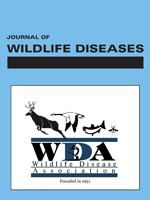Morbidity and mortality of captive wildlife at the Emperor Valley Zoo, Trinidad from 1993 to 1996 were analysed to determine involvement of Salmonella spp. A 6 mo longitudinal study was conducted to determine the frequency of isolation of Salmonella spp. from apparently healthy, sick and dead wild mammals, birds, and reptiles. The antibiograms of Salmonella isolates were determined using the disc diffusion method. Fecal samples randomly selected from animal enclosures and cloacal swabs of snakes were cultured for Salmonella spp. following enrichment in tetrathionate and selenite cystine broths. For the 1993–96 period, Salmonella spp. was implicated in 17 (12%) of 141 sick or dead animals and the predominant serotype was S. typhimurium. During the 6 mo prospective study in a mean animal population of 1,186, there were 20 (2%) and 14 (1%) animals that were sick and died respectively; Salmonella spp. was implicated in only one mortality. Overall, of 1,012 samples from apparently healthy wildlife cultured, 66 (7%) yielded 24 serotypes of Salmonella. The predominant serotype were S. seigburg (16 isolates), S. gaminara (6 isolates), and S. thompson (6 isolates). None of the samples yielded S. typhimurium. The frequency of isolation of Salmonella spp. in reptiles (14%) was significantly higher than found in either mammals (7%) or birds (3%). Sixty-five (99%) of 66 Salmonella spp. isolates exhibited resistance to one or more of the nine antimicrobial agents tested. Resistance was high to cephalothin (92%), moderate to streptomycin (35%) and tetracycline (29%), but significantly low to gentamicin (2%), chloramphenicol (0%), and sulphamethoxazole/trimethoprim (0%). The prevalence of asymptomatic infections by Salmonella spp. in zoo animals was high and the very high prevalence of antimicrobial resistance could be a problem when treating salmonellosis.
How to translate text using browser tools
1 April 2000
RETROSPECTIVE AND LONGITUDINAL STUDY OF SALMONELLOSIS IN CAPTIVE WILDLIFE IN TRINIDAD
Neera V. Gopee,
Abiodun A. Adesiyun,
Kenneth Caesar

Journal of Wildlife Diseases
Vol. 36 • No. 2
April 2000
Vol. 36 • No. 2
April 2000
captive wildlife
Salmonella spp.
salmonellosis
survey
zoo




